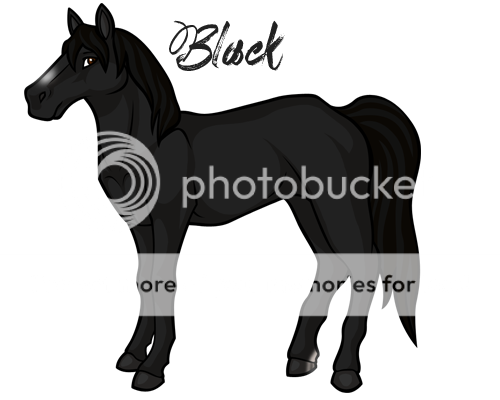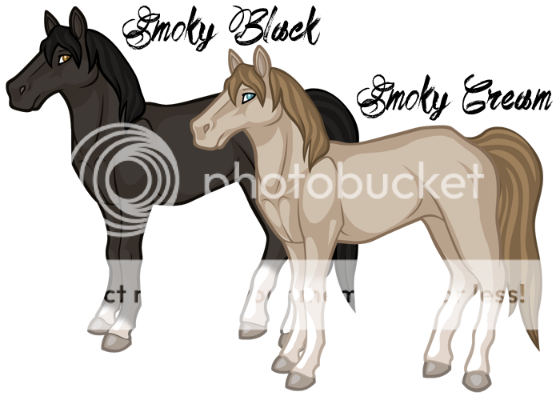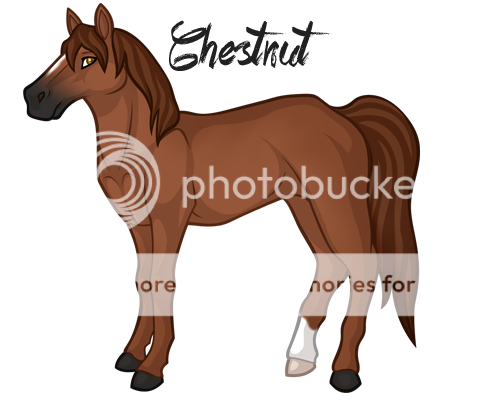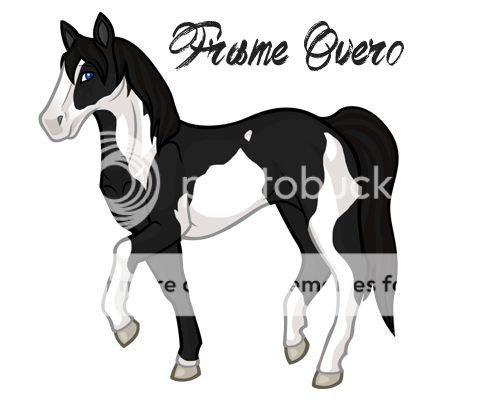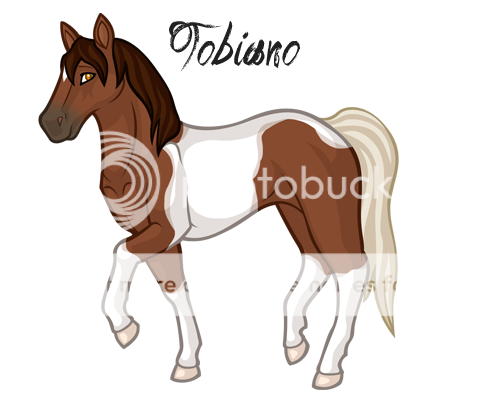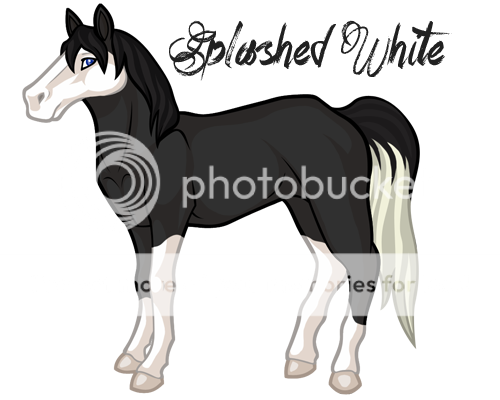|
|
|
|
|
|
|
|
|
 Posted: Sun Nov 16, 2014 5:07 pm Posted: Sun Nov 16, 2014 5:07 pm
Under Contruction, will be updating frequently with pictures and examples
This guide should give you a good idea of what colors are allowed at the shop. Remember, there are unlimited shades of each color that can be used. One brown horse may look completely different from another.
The horses pictured below are just one example that can fall under each category. Horses belong to their respective owners.
Most of this information is from wikipedia, and can be found by searching any of the terms.
Note: This guide only covers colors that are recognized in Thoroughbreds, not every possible equine color.
|
 |
 |
|
|
|
|
|
|
|
|
|
|
|
|
 Posted: Mon Nov 17, 2014 6:43 am Posted: Mon Nov 17, 2014 6:43 am
What Color is my Horse?
Before you can understand which genes you horse carries, it helps to know the color of your horse. If you are really unsure, you can always PM me and I'll help you.
Commonly Mixed-up Colors
Black and Smoky Cream
Black horses are very dark, while smokey creams are more of a dark grey
Brown and Bay
Brown horses are much darker, and have lighter underparts, while bays are usually a solid lighter brown. Both have darker legs.
Bay and Chestnut
Chestnut horses are a uniform color. Bay horses have dark legs.
Diluted Colors
Buckskin and Perlino are dilutions of bay, and therefore have dark legs. Other diluted horses have solid colors.
Champagne Horses
Champagne horses have glossy coats and hazel eyes.
|
 |
 |
|
|
|
|
|
|
|
|
|
|
|
|
|
|
|
 Posted: Mon Nov 17, 2014 6:43 am Posted: Mon Nov 17, 2014 6:43 am
Black:Black is a hair coat color of horses in which the entire hair coat is black. Black is a relatively uncommon coat color, and it is not uncommon to mistake dark chestnuts or bays for black. True black horses have dark brown eyes, black skin, and wholly black hair coats without any areas of permanently reddish or brownish hair. They may have pink skin beneath any white markings under the areas of white hair, and if such white markings include one or both eyes, the eyes may be blue. Brown:Brown is a hair coat color of horses characterized by a brown body color; with black points, the mane, tail and legs; but also reddish or tan areas around the eyes, muzzle, behind the elbow and in front of the stifle. Smoky Black:Smoky black, a horse with a black base coat and one copy of the cream allele, is less well-known than the two golden shades. Since a single copy of the cream gene primarily affects red pigment, with only a subtle effect on black, smoky blacks can be quite difficult to identify. Smoky Cream:Smoky Creams are homozygous cream blacks, and very difficult to visually distinguish from cremellos or perlinos. Classic/Sable Champagne:Classic champagne is, as its name suggests, the coat color most associated with the champagne gene. It is produced by the action of champagne on a black coat. The body coat is chocolate, the mane and tail a darker shade. The legs may also be slightly darker. The overall effect has also been described as lilac, dark taupe, and even green. Sable champagne is produced by the action of champagne on a seal brown coat. It is visually difficult to distinguish from classic champagne.
|
 |
 |
|
|
|
|
|
|
|
|
|
|
|
|
 Posted: Mon Nov 17, 2014 6:43 am Posted: Mon Nov 17, 2014 6:43 am
Bay:Bay is a hair coat color of horses, characterized by a reddish brown body color with a black mane, tail, ear edges, and lower legs. Bay is one of the most common coat colors in many horse breeds. The black areas of a bay horse's hair coat are called "black points", and without them, a horse cannot be a bay. Black points may sometimes be covered by white markings, however such markings do not alter a horse's classification as "bay". Bay horses have dark skin, except under white markings, where the skin is pink. Buckskin:Buckskin is a hair coat color of horses; referring to a color that resembles certain shades of tanned deerskin. The horse has a tan or gold colored coat with black points (mane, tail, and lower legs). Buckskin occurs as a result of the cream dilution gene acting on a bay horse. Perlino:Perlinos are homozygous cream bays, which also have a cream-colored body but a mane and tail that may be somewhat more reddish in color than a cremello. Amber Champagne:Amber champagne is produced by the action of champagne on a bay coat. The coat is reddish-gold with chocolate points. Just as there are varying shades of bay, the gold body coat may vary in shade as well. The legs are sometimes lighter than the mane and tail, and the colored points may be difficult to see. The mane and tail may also have "frosting" or light edges.
|
 |
 |
|
|
|
|
|
|
|
|
|
|
|
|
|
|
|
 Posted: Mon Nov 17, 2014 6:43 am Posted: Mon Nov 17, 2014 6:43 am
Chestnut:Chestnut is a hair coat color of horses consisting of a reddish-to-brown coat with a mane and tail the same or lighter in color than the coat. Chestnuts have dark brown eyes, black skin, and a coat that is entirely devoid of true black hairs. Typical chestnuts are some shade of red or reddish brown. The mane, tail, and legs may be lighter or darker than the body coat, but are never truly black. They may have pink skin beneath any white markings under the areas of white hair, and if such white markings include one or both eyes, the eyes may be blue. Palomino:Palomino is a coat color in horses, consisting of a gold coat and white mane and tail. Genetically, the palomino color is created by a single allele of a dilution gene called the cream gene working on a "red" (chestnut) base coat. Cremello:Cremellos are homozygous cream chestnuts, and have a cream colored body with a cream or white mane and tail. Gold Champagne:Gold champagne is produced by the action of champagne on a chestnut coat. The coat is gold, and the mane and tail are typically ivory. In some cases, the mane and tail may be self-colored, matching the body coat. These gold champagnes are sometimes called "dark gold" and may be an all-over apricot shade.
|
 |
 |
|
|
|
|
|
|
|
|
|
|
|
|
 Posted: Mon Nov 17, 2014 6:44 am Posted: Mon Nov 17, 2014 6:44 am
Dominant White:Dominant white is best known for producing pink-skinned all-white horses with brown eyes, though some dominant white horses have residual pigment along the topline. Horses with full Sabino-white are indistinguishable from dominant whites.
|
 |
 |
|
|
|
|
|
|
|
|
|
|
|
|
|
|
|
 Posted: Mon Nov 17, 2014 6:44 am Posted: Mon Nov 17, 2014 6:44 am
Face Markings:--- Leg Markings:---
|
 |
 |
|
|
|
|
|
|
|
|
|
|
|
|
 Posted: Wed Nov 19, 2014 7:00 pm Posted: Wed Nov 19, 2014 7:00 pm
Frame Overo:A frame overo horse appears to be any solid base color (bay, black, chestnut, etc.) with white irregular patches added, usually with a horizontal orientation. Markings are often of jagged shape rather than rounded, the white rarely crosses the back, the lower legs tend to be dark, and the tail is one color, usually dark. The head is often white or bald-faced, and blue eyes are not uncommon. Tobiano:Tobiano coloring is the inverse of Overo spotting. Tobianos have a vertical spotting pattern, large, rounded spots, white that crosses the topline, dark heads, but mostly white legs and white or multi-colored tail. Typical examples tend to have more white than dark, whereas typical frame overo horses tend to more dark than white, though there are many exceptions in both cases. Sabino:Sabino patterning is visually recognized by roaning at the edges of white markings, belly spots, irregular face markings, especially white extending past the eyes or onto the chin, white above the knees or hocks, and "splash" or "lacy" marks anywhere on the body, but particularly on the belly. Some sabinos have patches of roan patterning on part of the body, especially the barrel and flanks. Some sabinos may have a dark leg or two, but many have four white legs. Both blue and brown eyes are seen. The most generous definition of sabino can include horses with as little white as a chin or lower lip spot. Splashed White:A splash or splashed white overo pattern appears like a solid-colored horse who has been dipped in white paint, and the color splashed up from the bottom. It is the least common of the overo patterns. The legs and bottom portion of the body are usually white, as is the head, and blue eyes are common. Edges where white and dark color meet are usually crisp and sharp. Grey:Gray or grey is a coat color of horses characterized by progressive silvering of the colored hairs of the coat. Most gray horses have black skin and dark eyes; unlike many depigmentation genes, gray does not affect skin or eye color. Their adult hair coat is white, dappled, or white intermingled with hairs of other colors. Gray horses may be born any base color, depending on other color genes present. White hairs begin to appear at or shortly after birth and become progressively lighter as the horse ages. Graying can occur at different rates—very quickly on one horse and very slowly on another.
|
 |
 |
|
|
|
|
|
|
|
|
|
|
|
|
|
|
|
 Posted: Wed Dec 17, 2014 10:05 am Posted: Wed Dec 17, 2014 10:05 am
White Brindle:
Most brindle horses have dark stripes on a lighter body color, but a rare few have white stripes on a dark body color. While it is possible that white brindles are chimeric (and certainly some may be), the current thought is that the color is probably the result of a one-time mutation, probably of rabicano. Simply put, that means that the white brindling color is unlikely to be passed on to a horse's offspring, but the mutation may manifest in a different form resulting in unique offspring
Birdcatcher spots:
Birdcatcher spots are small, round, white spots scattered throughout a horse's coat. In many cases, the spots appear and grow in number for a period of years, and then gradually fade away. Sometimes, the spots will persist throughout a horse's lifetime.
Bend Or Spots:
These spots are also named for the stallion who bore them. They are random dark spots on a lighter coat, often seen on chestnuts and palominos. They vary in size, sometimes only dime-sized, and sometimes as big as an outspread hand.
|
 |
 |
|
|
|
|
|
|
|
|
|
|
|
|
 Posted: Wed Dec 17, 2014 10:05 am Posted: Wed Dec 17, 2014 10:05 am
Base Color Genes
Dominant White:
W W: Lethal; no horse will have this
W w: Full white, masks all other colors
w w: Not full white
Extension Gene
E E: Black
E e: Black
e e: Chestnut
Agouti Gene
A A: Black turns to Bay
A a: Black turns to Bay
A At: Black turns to Bay
At At: Black turns to Brown
At a: Black turns to Brown
a a: No effect
Cream
Cr Cr: Black/Brown turns to Smokey Cream; Bay turns to Perlino; Chestnut turns to Cremello
Cr cr: Black/Brown turns to Smokey Black; Bay turns to Buckskin; Chestnut turns to Palomino
cr cr: No effect
Champagne: (overpowers cream gene)
Ch Ch: Black/Brown turns to Classic Champagne; Bay turns to Amber Champage; Chestnut turns to Gold Champagne
Ch ch: Black/Brown turns to Classic Champagne; Bay turns to Amber Champage; Chestnut turns to Gold Champagne
ch ch: No effect
|
 |
 |
|
|
|
|
|
|
|
|
|
|
|
|
|
|
|
 Posted: Wed Dec 17, 2014 10:05 am Posted: Wed Dec 17, 2014 10:05 am
White Markings:
Grey
G G: Almost all white as adult
G g: Partially white as adult; dapped
g g: No greying
Sabino:
Sb Sb: Large amount of sabino white
Sb sb: Small amount of sabino white
sb sb: No sabino white
Tobiano:
TO TO: Tobiano white
TO to: Tobiano white
to to: No tobiano white
Overo:
O O: Lethal white syndrome; no living horses will have this
O o: Frame overo white
o o: No overo white
Splash White:
Sp Sp: Face, legs and stomach white
Sp sp: Face and legs white
sp sp: No splash white
|
 |
 |
|
|
|
|
|
|
|
|
|
|
|
|
 Posted: Thu Dec 18, 2014 1:39 pm Posted: Thu Dec 18, 2014 1:39 pm
Other
Face and Leg Markings
Horses will inherit face or leg markings from either or both parents. This is CC and will vary from breeding to breeding. This will also be used to keep siblings looking different from each other, in the case of limited genetics.
Misc. Markings
Things such as Birdcatcher Spots or BendOr spots will typically be passed down, but not always.
Other Colors
Other areas of color differences, such as the darkness or lightness of the base coat, or muzzle/stomach coloring will be incorporated into offspring.
Eye Color
Most horses have brown/green/amber eyes. Some genes allow them, or force them, to have blue eyes. Champagne horses have hazel eyes. If it's not one of the genetic cases, the foals will get the eye color from one of their parents.
|
 |
 |
|
|
|
|
|
|
|
|
|
 |
|
|
|
|
|
|


